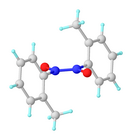Nitroso

In
Synthesis
Nitroso compounds can be prepared by the reduction of nitro compounds[1] or by the oxidation of hydroxylamines.[2] Ortho-nitrosophenols may be produced by the Baudisch reaction. In the Fischer–Hepp rearrangement aromatic 4-nitrosoanilines are prepared from the corresponding nitrosamines.
Properties

Nitrosoarenes typically participate in a
When stored in protic media, primary and secondary nitrosoalkanes isomerize to oximes.[5]
Due to the stability of the nitric oxide
Reactions
Many reaction exists which make use of an intermediate nitroso compound, such as the Barton reaction and Davis–Beirut reaction, as well as in the synthesis of indoles, for example: Baeyer–Emmerling indole synthesis, Bartoli indole synthesis. In the Saville reaction, mercury is used to replace a nitrosyl from a thiol group.
C-nitroso compounds are used in organic synthesis as synthons in some well-documented chemical reactions such as hetero Diels-Alder (HDA), nitroso-ene and nitroso-aldol reactions.[8]
Nitrosation vs. nitrosylation
Nitrite can enter two kinds of reaction, depending on the physico-chemical environment.
- Nitrosylation is adding a nitrosyl ion NO− to a metal (e.g. iron) or a thiol, leading to nitrosyl iron Fe−NO (e.g., in nitrosylated heme = nitrosylheme) or S-nitrosothiols (RSNOs).
- . This conversion occurs at acidic pH, particularly in the stomach, as shown in the equation for the formation of N-phenylnitrosamine:
- NO−2 + H+ ⇌ HONO
- HONO + H+ ⇌ H2O + NO+
- C6H5NH2 + NO+ → C6H5N(H)NO + H+
Many primary alkyl N-nitroso compounds, such as CH3N(H)NO, tend to be unstable with respect to hydrolysis to the alcohol. Those derived from secondary amines (e.g., (CH3)2NNO derived from dimethylamine) are more robust. It is these N-nitrosamines that are carcinogens in rodents.
Nitrosyl in inorganic chemistry

Nitrosyls are non-organic compounds containing the NO group, for example directly bound to the metal via the N atom, giving a metal–NO moiety. Alternatively, a
- NO + e− → NO−
Oxidation of NO yields the
- NO → NO+ + e−
Nitric oxide can serve as a
In human health
Nitroso compounds react with
For example, during the 1970s, certain Norwegian farm animals began exhibiting elevated levels of liver cancer. These animals had been fed herring meal preserved with sodium nitrite. The sodium nitrite had reacted with dimethylamine in the fish and produced dimethylnitrosamine.[14]
The effects of nitroso compounds vary dramatically across the gastrointestinal tract, and with diet. Nitroso compounds present in stool do not induce nitrosamine formation, because stool has neutral
See also
- Nitrosamine, the functional group with the NO attached to an amine, such as R2N–NO
- Nitrosobenzene
- Nitric oxide
- Nitroxyl
References
- .
- ^ Calder, A.; Forrester, A. R.; Hepburn, S. P. "2-Methyl-2-nitrosopropane and Its Dimer". Organic Syntheses. 52: 77; Collected Volumes, vol. 6, p. 803.
- S2CID 95291018.
- PMID 26730505.
- (Tilden lecture).
- ISBN 9781420007282.
- PMID 11942786.
- .
- PMID 22062097.
- PMID 17052997.
- S2CID 4951579.
- S2CID 13274953.
- PMID 16865769.
- ISBN 978-1-4614-1586-2.
- PMID 7285009.
- PMID 17761300.
- S2CID 26275960.
- S2CID 196379002.
- S2CID 41045030. Retrieved 2015-06-06.
Evidence now exists that ascorbic acid is a limiting factor in nitrosation reactions in people.
- PMID 17785370.
- PMID 20026204.
